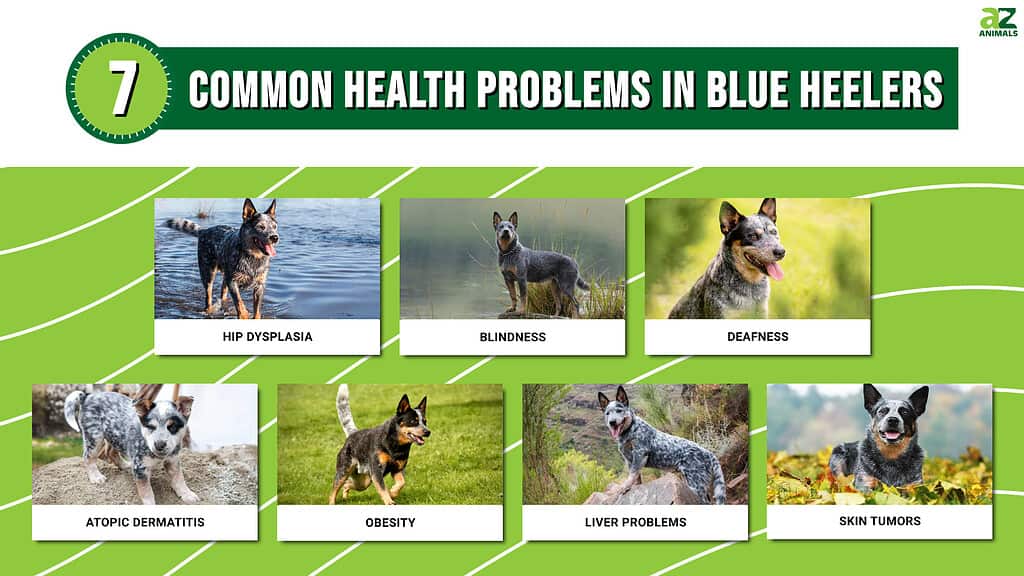
Blue heelers (Australian cattle dogs) are a unique breed that has been becoming more and more popular for dog lovers in recent years. They are known for their wild and exuberant energy, which makes them great for people who want an extremely active dog.
Oftentimes, their energy can make them prone to a few injuries. Likewise, there are some genetic statistics regarding other health problems that blue heelers commonly experience.
Do Blue Heelers Experience a Lot of Health Problems?
Like any other dog breed, blue heelers do come with their laundry list of common health problems. They are also a pretty hardy breed, known for living full lives. One of the oldest recorded dogs was a blue heeler named Bluey!
Without further ado, let’s take a look at some of the most common health problems among blue heelers, as well as what they may look like along the course of their life.
1. Hip Dysplasia

Active dogs like blue heelers are at risk of hip dysplasia, especially in relation to running injuries.
©Madelein_Wolf/ via Getty Images
Hip dysplasia is a huge problem among many popular dog breeds. It is a disease characterized by the incorrect placement or functioning of the hip joints. Typically, dysplasia occurs over time as dogs age. While it can be caused by excessive activity or injury, there is also a genetic propensity for the disease, which blue heelers unfortunately have.
In tandem with their size, blue heeler owners should be wary of their beloved pets developing dysplasia. Luckily, there are a lot of modern techniques that can be used to detect and help mitigate the effects of dysplasia!
2. Blindness

While they are a relatively healthy breed, blue heelers due have some genetic propensity for blindness.
©WOLF AVNI/Shutterstock.com
Many blue heelers also have genetic biases toward blindness. Blindness is such an issue that many breeders have their pairs and litters tested to ensure that cases diminish in the blue heeler market.
Blindness is usually something that develops as a dog ages, typically with the onset of symptoms around age 6-7.
3. Deafness

Blindness is one of the hardest illnesses to diagnose in blue heelers, usually due to their ability to cheat during hearing tests!
©Tatyana Consaul/ via Getty Images
Similarly to blindness, many blue heelers are also genetically disposed to be deaf. Many standardized tests are used to test if puppies and adults are deaf. One major test is called the BAER (brainstem auditory evoked response) test. It can be used with many animals, including humans, and it generally measures the response to auditory stimuli.
One interesting thing about blue heelers is that their intelligence can sometimes interfere with the test for deafness. In some cases, puppies and adults were correctly able to mimic and understand the “correct” response for the test, which resulted in many false negatives!
4. Atopic Dermatitis

Just like many other dog breeds, atopic dermatitis can be a huge issue for blue heelers.
©Petra Richli/ via Getty Images
Another condition that a lot of dogs face is atopic dermatitis. This condition is characterized by excessive irritation and itchiness of the skin. As mentioned, it isn’t restricted to blue heelers alone. It is one of the most common ailments faced by almost all dog breeds.
Aside from rare cases where dermatitis is caused by a chemical irritant or injury, most cases are caused by natural irritants, known as allergens. Unfortunately, dermatitis is usually a long-term condition that is genetically predisposed.
Some remedies can help alleviate your dog’s symptoms, such as topical ointments, shampoos, and even medications. As with most conditions, it is always best to consult your veterinarian before trying out new solutions.
5. Obesity

Giving your blue heeler the right diet and enough exercise is advised to avoid problems related to obesity.
©LNbjors/Shutterstock.com
Although it may sound odd for an ailment such as obesity to affect an active breed, it is a relatively prevalent problem in blue heelers. These dogs are well suited for rigorous activity, however, they aren’t opposed to sleeping all day as well.
Thus, many owners fail to give their blue heelers enough opportunities to exercise, and often feed them too much, which leads to obesity.
6. Liver Problems

Liver problems can range from mild to severe in blue heelers. Sometimes, your dog can avoid liver-related issues given the right diet!
©Madelein Wolfaardt/Shutterstock.com
One group of problems that many blue heelers experience are liver-related issues. Many sources agree that blue heelers are one of the top breeds for liver diseases.
One liver disease that is seen in blue heelers is called portosystemic shunt (PSS). It is an illness in which your dog’s blood is shunted around the liver instead of through it. This essentially deprives the liver of blood and reduces its ability to filter out toxins and waste.
Don’t worry though! Some great solutions can help your dogs with issues such as this, ranging from diet changes to surgery!
7. Skin Tumors

Checking your blue heeler regularly for odd skin growths such as tumors is incredibly important!
©Best dog photo/Shutterstock.com
Finally, tumors and other related skin issues are another big group of problems in the blue heeler breed. Particularly, mast cell tumors are especially common. Like any other skin tumor, they can appear as lumps, bumps, and weird growths.
Unfortunately, many tumors that can develop on your blue heeler can appear to be regular blemishes, which makes diagnosing them a challenge!
| Bodily System Involved | Illness Name |
|---|---|
| Skeletal system | Hip dysplasia |
| Nervous system | Blindness |
| Nervous system | Deafness |
| Integumentary (skin) system | Atopic Dermatitis |
| Endocrine system | Obesity |
| Circulatory system | Liver Problems (PSS) |
| Integumentary (skin) system | Skin tumors |
The photo featured at the top of this post is © Fischer S./iStock via Getty Images
Ready to discover the top 10 cutest dog breeds in the entire world?
How about the fastest dogs, the largest dogs and those that are -- quite frankly -- just the kindest dogs on the planet? Each day, AZ Animals sends out lists just like this to our thousands of email subscribers. And the best part? It's FREE. Join today by entering your email below.
Thank you for reading! Have some feedback for us? Contact the AZ Animals editorial team.






